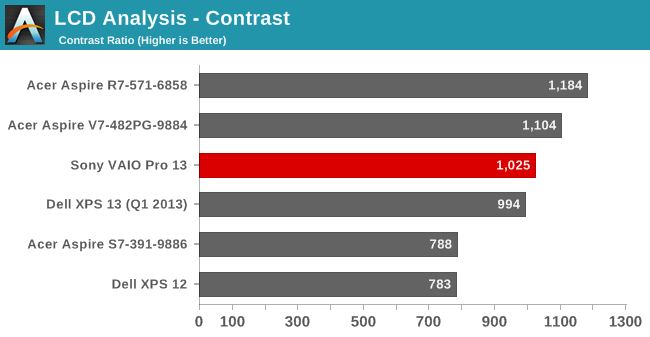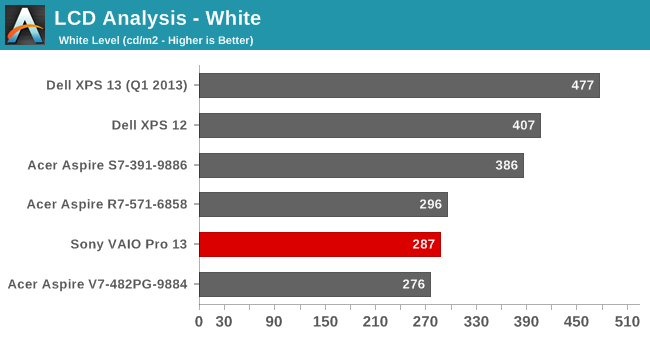Sony VAIO Pro 13: Exceptionally Portable
by Jarred Walton on October 16, 2013 12:00 AM ESTA Great Display
Wrapping up our testing, we have the display along with some figures for temperatures and noise levels. Starting with the display, I actually have a problem with my i1 Display2 colorimeter – it reports numbers, but the calibration is all messed up. I have another colorimeter, an older DTP-94 that still works well, but it doesn't work with ColorEyes Display Pro under 64-bit Windows. What I ended up doing was measuring the white and black levels with the DTP-94 using a separate PC (an old laptop running Windows XP), which also give me contrast, but I don't have Delta E or gamut numbers right now.
At some point we will be moving towards a better test regimen for laptop displays, similar to what we do on tablets and smartphones. Most users don't have a colorimeter, so the out-of-box experience is far more important than the calibrated result – and nearly all displays calibrate fairly well. This will hopefully help to encourage the laptop manufacturers to put more effort into delivering good quality calibrated displays, similar to what we've seen from Apple with their latest iPad, iPhone, iMac, and MacBook Retina products. And with that said, here are the brightness and contrast graphs.



The VAIO Pro 13 has a reasonably bright backlight, but we still would like to see maximum white levels of 400 nits, as that helps with outdoor use. This laptop is so targeted at mobility that the lack of a brighter display could definitely be seen as a drawback. As for black levels and the resulting contrast, the LCD does very well, with a contrast ratio of over 1000:1. Acer's S7 potentially has a slightly better display, based on these results, but I think the colors on the Sony are actually a bit better and hopefully I can get the colorimeter situation sorted out soon enough to update this section. Anyway, I do like the Sony display quite a lot and think it's one of the best aspects of the VAIO Pro 13.
Temperatures and Noise Levels
Considering the apparent throttling that was taking place in some tests – at the very least the CPU/GPU are not running anywhere near maximum Turbo speeds – I was curious to see what the temperatures looked like under load. We've seen many an Ultrabook hit 90C or higher under load, but Sony bucks that trend in a serious way. I don't think it's just the cooling either, as the laptop doesn't get exceptionally loud. Instead, it's Sony's firmware favoring lower Turbo Boost levels in order to keep temperatures down. Here's what we found in our stress testing:

After running our stress test all night (and then some), the maximum package temperature ended up at just 76C. That's a result more than a few desktops would be happy to equal, and we're dealing with an extremely thin chassis. Even the airflow from the vent on the side doesn't feel that hot, and covering it with my hand didn't get uncomfortable – and it didn't increase the noise levels or temperatures either! Instead, clock speeds dropped slightly and the system continued chugging happily along at 76C or less.
As for noise levels, at idle and light loads the fan is off and thus the VAIO Pro 13 is completely silent. Once the CPU temperature hits I think 40C or more, the fan begins to spin, and in most cases it will be at the minimum speed, which results in a noise level of 32dB from a distance of around 18 inches (45cm). The fan speed and resulting noise levels begin ramping up until the fan is running at maximum at 50C or higher, with a resulting noise level of 42dB. It's a gradual ramp in fan speed as well, which is nice to see – a lot of laptops have three or four discrete speeds with a substantial difference in noise levels at each speed. Considering this isn't really a laptop designed for complex computational tasks (not that it can't do some of them, but it's no mobile workstation), most users will find the laptop typically runs at very low fan speeds or even silently.


_thumb.JPG)
_thumb.JPG)
_thumb.JPG)
_thumb.JPG)
_thumb.JPG)
_thumb.jpg)








106 Comments
View All Comments
JarredWalton - Wednesday, October 16, 2013 - link
The sheet battery raises the back about half an inch (1.34" total height at rear -- 34.1mm) and according to my little food scale the laptop with the battery weighs 2.97 pounds (1.348kg).Amkitsaw - Wednesday, October 16, 2013 - link
Thanks so much! It's a great review; I completely agree with your assessment at the end about manufacturers raising the ~$1200 ultrabook spec to 8GB/256GB. It's a little ridiculous so many manufacturers are holding onto 4GB in 2013.teiglin - Wednesday, October 16, 2013 - link
Nice review as always, Jarred. One issue though--my Vaio Pro 13 claims to have Dual-Band Wireless-N 7260 (<3 Intel part naming) and has no apparent issues connecting to my 5GHz AP. Is it possible that this varies between models?The one other downside of the flex-y chassis you don't mention (maybe didn't encounter?) is that you can actually click the clickpad by pressing down on either side of the touchpad, or by placing a thumb between the touchpad and the edge, and lifting the laptop with your hand underneath it. Practically this is only very rarely an issue (if I'm walking around and holding the laptop by the front, mostly--and the lightness makes this something I do more often than I would have thought), but it bears mentioning.
On the pricing front, I would love to see Sony come down a bit, but it's been four months and there is still pretty sparse competition. There's the Acer S7--on Amazon, $1300 for the i5/128GB SSD/8GB RAM model, or $1580 for i7/256GB SSD upgrade--or the ATIV Book 9 for $1400, but in order to get its beautiful screen, you have to suffer its ridiculous single configuration of 128GB SSD/4GB RAM. Dell's XPS 13 is still Ivy if you buy it today, and the XPS 12 is neither priced much better (especially with upgrades), nor to my mind a directly competing product. Especially now that you can shave $100 off by dropping the touchscreen, Sony's still at or near the front of the Haswell ultrabook pack in value here. It'll be interesting to see how the rMBP 13 compares--and the Zenbook Infinity, if it ever materializes.
teiglin - Wednesday, October 16, 2013 - link
Forgot to mention the Surface Pro 2, since you did--if you're comparing to that, you should probably compare the 11" flavor, which starts at $100 less than the 13 and essentially costs the same as Surface Pro 2 when you include a type cover. I do think for roughly the same price, Surface Pro wins that value comparison easily, though again if the tablet-y-ness isn't a factor you save $100 by dumping the touchscreen in the VAIO.Also on that topic, you wrote that Surface Pro 2 comes out in "ten weeks"--doesn't it come out next week? The Anandtech article (admittedly old at this point) says Oct 22.
JarredWalton - Wednesday, October 16, 2013 - link
Should have said 10 days. Heh. Wrote that earlier so now I need to edit it....7heF - Wednesday, October 16, 2013 - link
There is A LOT of Vaio Pro 13 owners that has huge wifi-problems. If you are in the same room as the AP, it can be ok, but some distance a a couple of walls and this pc is one of the worst on the market. No antenna in the screen - just a small cable behind the motherboard.I use a usb-dongle for wifi. With the internal solution, some of my 802.11g-based old pc's have much better range. My house ain't that large, but all over the house I can get coverage on the iPhone and the iPad - but with the Sony the performance is very low, unstable or completly without a connection.
Sony have for months said there will be an software update for this problem. I doubt it. I belive the antenna is the problem and that it really can't be fixed.
There is a huge thread at the Sony forums about the issue: http://community.sony.com/t5/VAIO-Hardware-Network...
JarredWalton - Wednesday, October 16, 2013 - link
Text on pages 2 and 6 has been updated. It's odd that the WiFi works so well within my home, but the exterior walls just kill throughput (assuming you can connect at all). I had some similar issues with the Acer R7, though oddly only on the 2.4GHz band.whatever61 - Wednesday, October 16, 2013 - link
You don't mention an important factor, that this laptop has a problematic wifi.There's no solution for months and probably the problem is in the hardware.
To be more specific, the speed drops drastically when the signal is not good. Some say it's because of a bad antenna location. Anyway, it's a very strong factor to take into account before buying this awesome (besides that one flaw) laptop.
Also, take into account that the back cover is very easily scratchable (way too easy!)
And yes, the extremely light weight is really exceptional!
JarredWalton - Wednesday, October 16, 2013 - link
As noted above, the text on pages 2 and 6 has been updated. Thanks!juhatus - Wednesday, October 16, 2013 - link
I bought the Vaio Pro 13 (i7-4500, 8Gb, 256gb toshiba ssd, no touch, 3year warranty) almost 2 months ago for 1200€. I must admit that it had it driver problems on start but every update has actually made a difference and now all problems are solved. It had a bit problems with fan, bluetooth and wifi, but as i said, updates solved those.I have to totally disagree with the "built quality"-issue, flexibility is by design not because they used sub-par engineering and materials. If you check how big the actual motherboard is, its about half of the depth of the laptop so its not flexing at all. One reviewer also noted that Sony has done these flexible design's before and now few years after those laptops haven't gotten any problems. If you close the lid than vaio 13 isnt bending almost at all. Jarred if you need a crowbar, than use something else than laptop :)
Jarred could you add some benchmarks about the ssd speed? If you get the samsung model.. its should do almost 1Gb/sec sequantials and the 4k read/writes arent that bad either. I got the 256gb toshiba and it still beats a samsung 840pro.
One thing about the display and calibration, Pro13 should use Sony's Tri-luminos tech and that surely could confuse the colormeter?